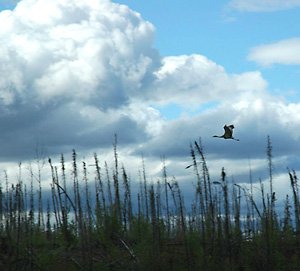Global Environmental Change: Impacts on Stickleback and their Watersheds
 Global warming and human development are having particularly extreme effects in south central Alaska. As is the case throughout Alaska, global warming is causing changes in lake productivity, alterations in lake and stream watersheds due to impacts from beetle infestations on the dominant spruce tree species, and an increased fire hazard. All of these changes influence the ecology of the lakes and streams in which stickleback are found. Particularly of concern is an apparent dramatic increase in the productivity of the mostly oligo- and mesotrophic lakes in the region. In addition, human development is leading alteration of lakes and streams due to physical modifications of the watersheds, and also via productivity increases associated with septic systems. We have discovered that increased lake productivity is causing rapid contemporary evolution in stickleback life histories, and are attempting to understand how global warming and development affect watersheds and, in turn, the stream and lacustrine communities they support.
Global warming and human development are having particularly extreme effects in south central Alaska. As is the case throughout Alaska, global warming is causing changes in lake productivity, alterations in lake and stream watersheds due to impacts from beetle infestations on the dominant spruce tree species, and an increased fire hazard. All of these changes influence the ecology of the lakes and streams in which stickleback are found. Particularly of concern is an apparent dramatic increase in the productivity of the mostly oligo- and mesotrophic lakes in the region. In addition, human development is leading alteration of lakes and streams due to physical modifications of the watersheds, and also via productivity increases associated with septic systems. We have discovered that increased lake productivity is causing rapid contemporary evolution in stickleback life histories, and are attempting to understand how global warming and development affect watersheds and, in turn, the stream and lacustrine communities they support.